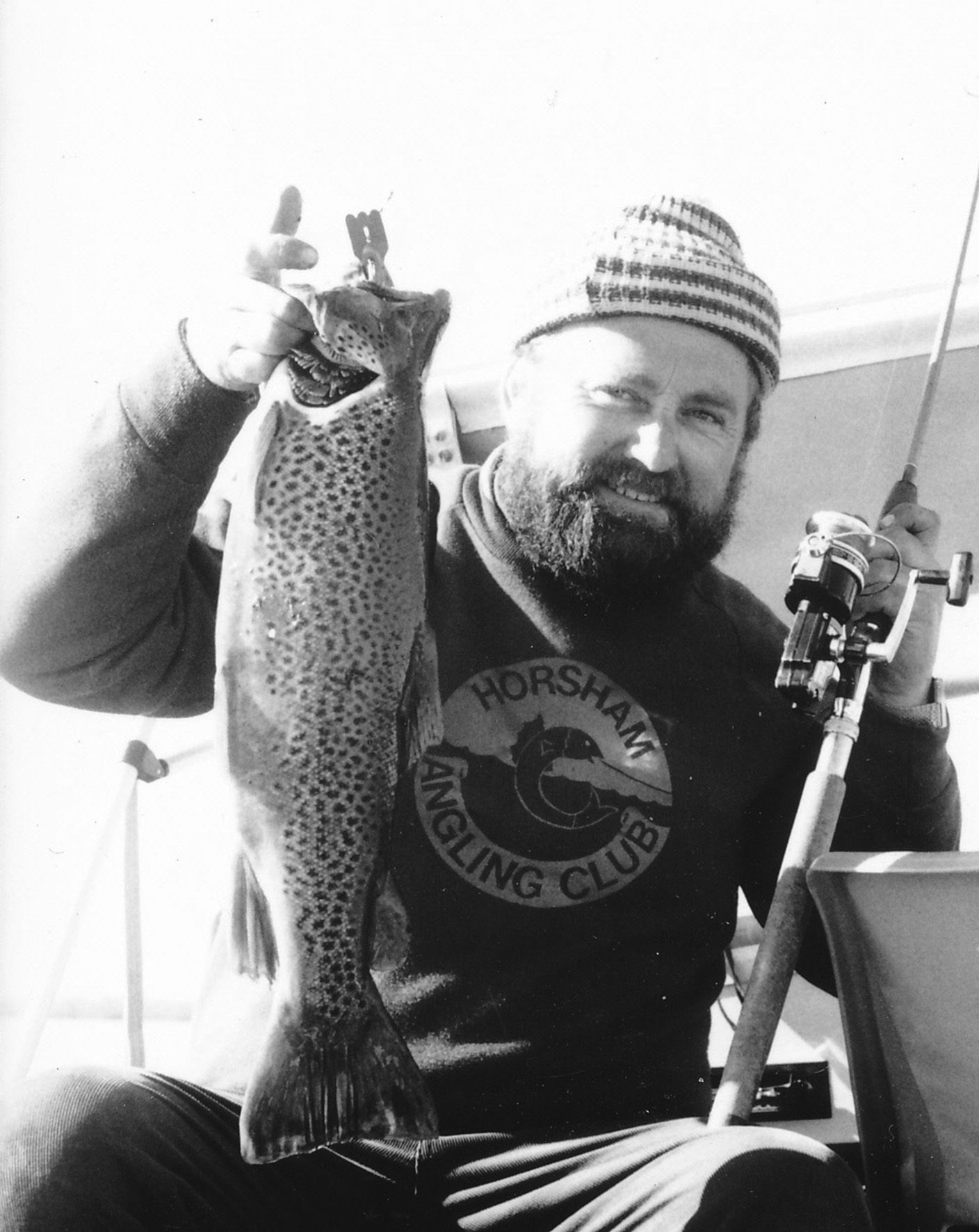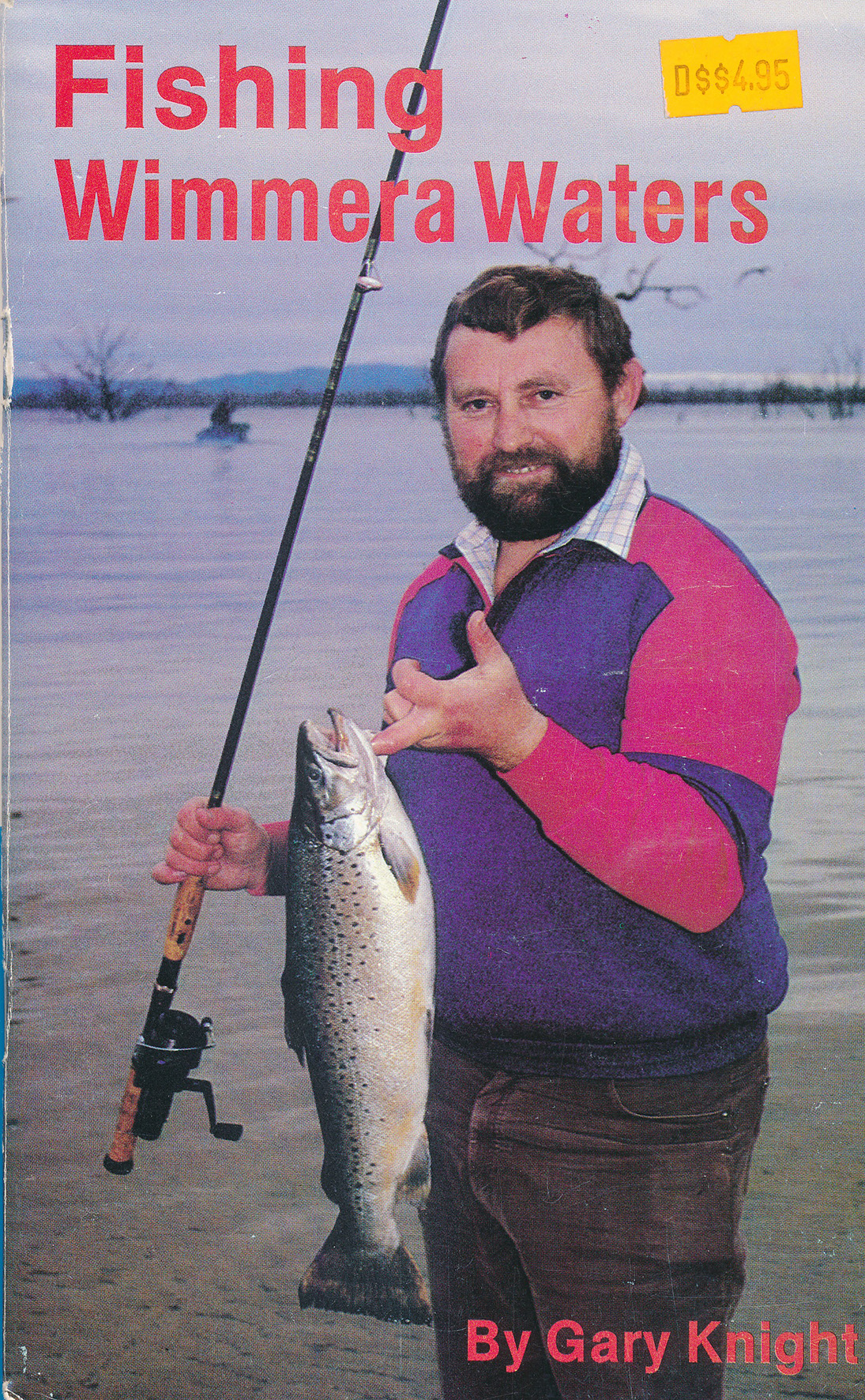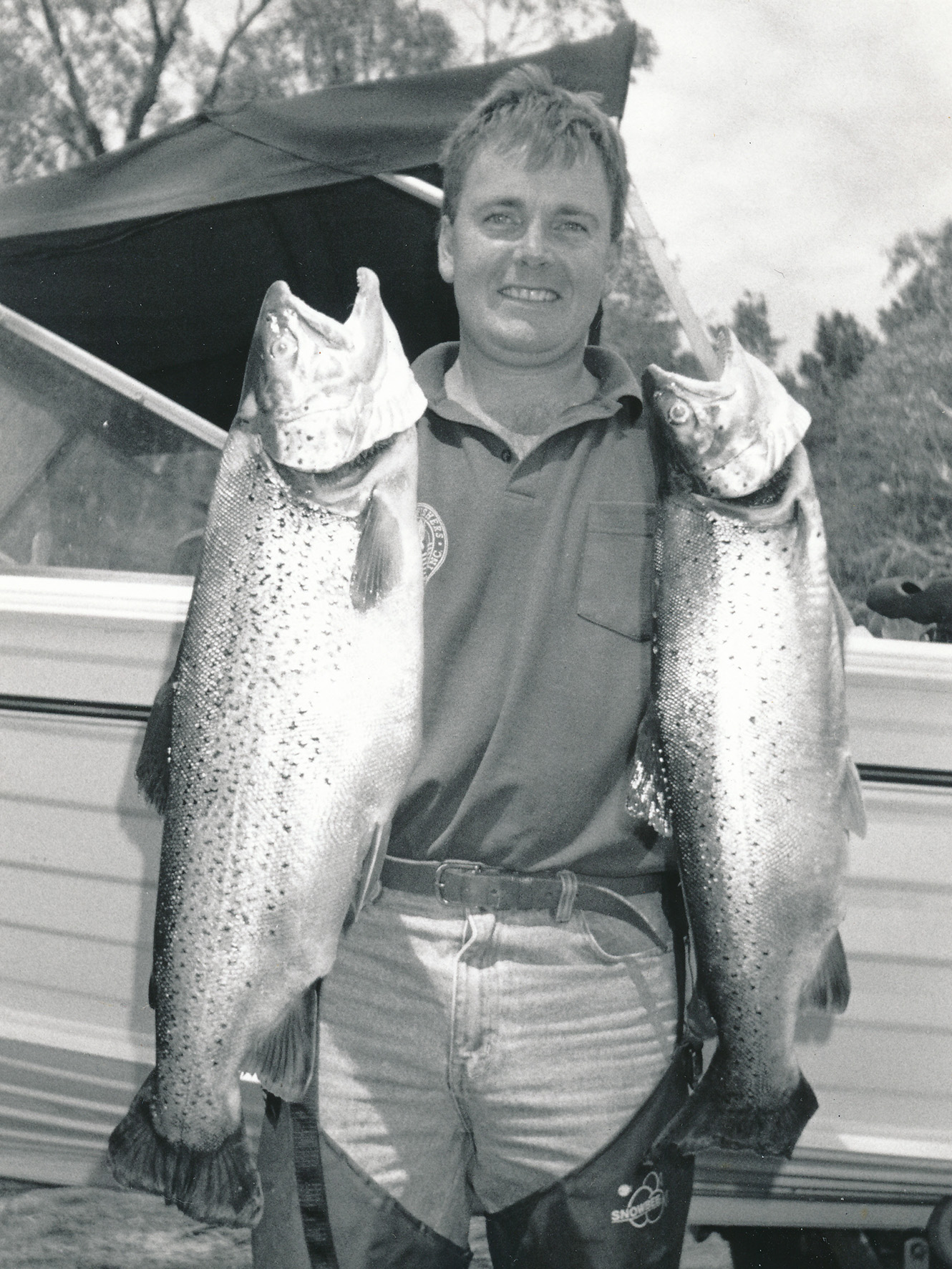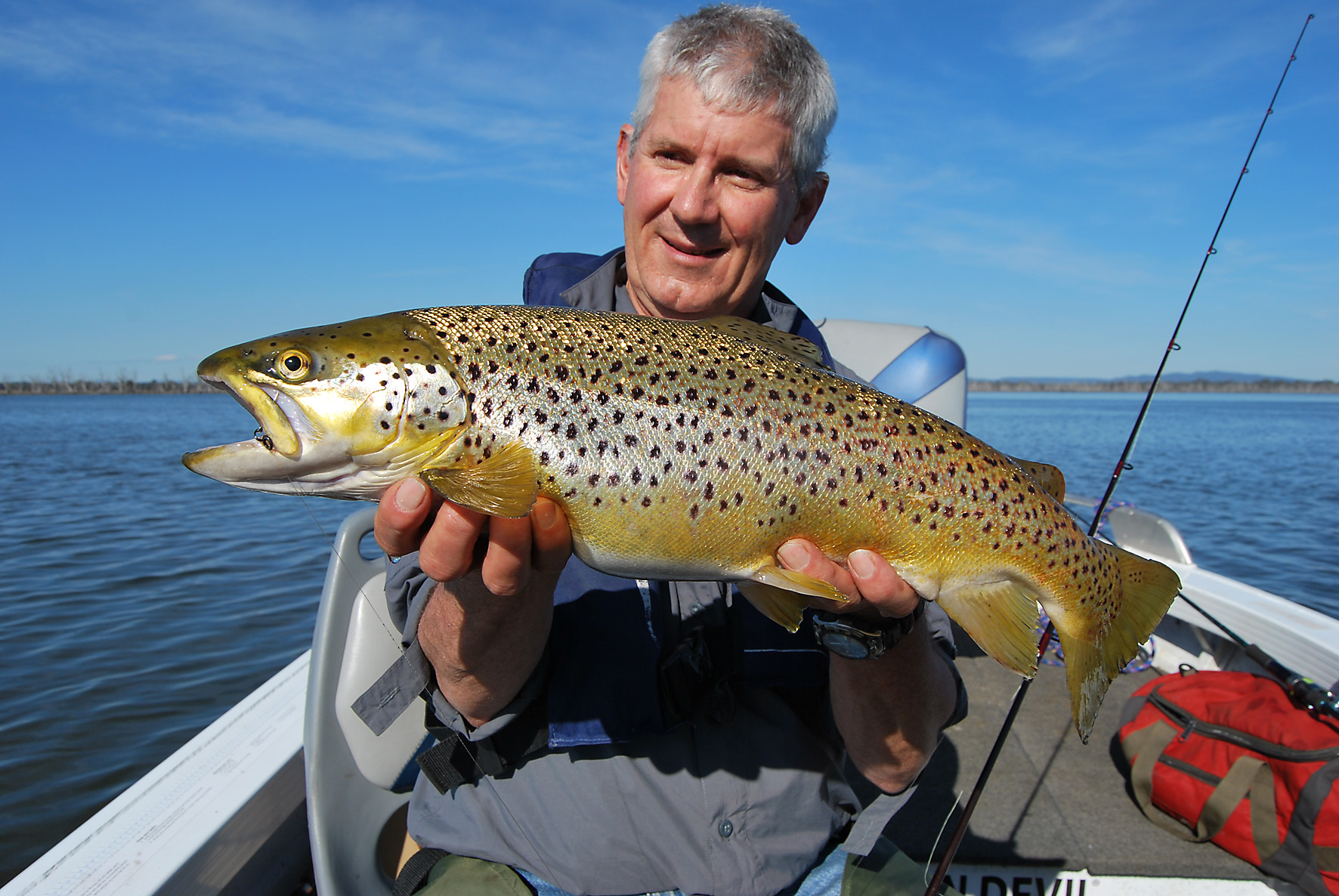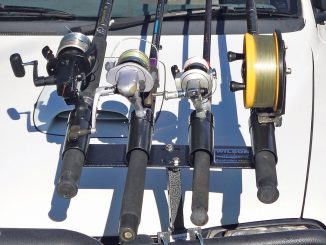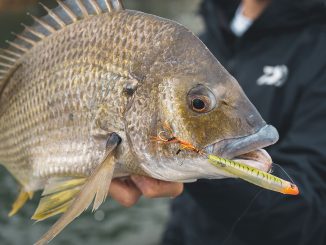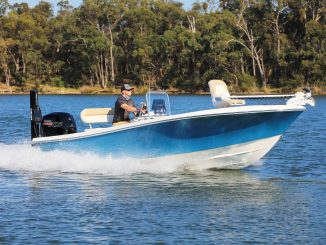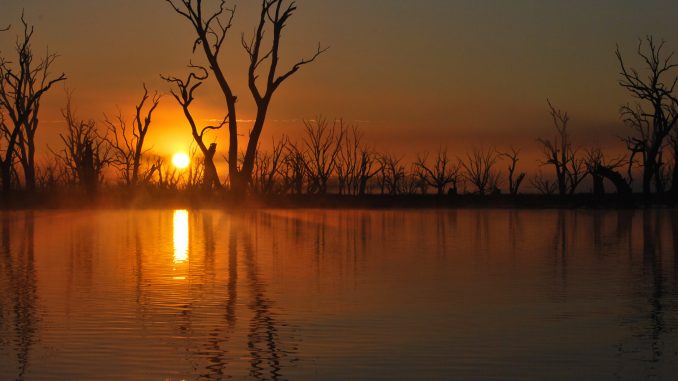
by Ross Winstanley •
In the post-Millennium Drought period since 2010, no Victorian impoundment has attracted more scrutiny by anglers and been the subject of more fishing-related political attention than Toolondo Reservoir. While the struggle to maintain enough water to sustain the fishery is sure to continue, Fisheries Victoria and anglers have moved on from the days of tense annual stocking discussions to a truly collaborative management approach.
Two weeks before the 2014 Victorian election, Opposition Leader Daniel Andrews announced that Labor would take action to maintain Lake Toolondo as Victoria’s best trout fishing location. That was a big call. Never before was there such a promise to maintain a trout fishery in a water-challenged region of Victoria where domestic and farming needs have long taken precedence over fishing.
THE EMERGENCE OF TOOLONDO RESERVOIR
As early as 1889, Barton Swamp was earmarked for development as a key part of the Glenelg water storage and distribution network for the Wimmera region. Since then, while its importance to Wimmera water supplies increased, then declined, tensions between water management and recreational fisheries interests have intensified.
At times early in the 20th century, Barton Swamp was full enough to warrant consideration as a fishing destination for Wimmera anglers. In 1929 it was stocked with redfin and, ever since, has been regarded as one of Victoria’s prime redfin fisheries. From the 1980s, during 18 years of netting surveys across the state, Toolondo consistently produced the biggest redfin, some reaching 2.5kg.
In 1953 Barton Swamp was established as an off-river storage basin as part of the Wimmera-Mallee water supply system, becoming known as Toolondo Reservoir. It continued as a redfin, tench and yabby water until 1965 when 26,880 rainbow trout were stocked; this was the first recognition of its potential as a sport fishery.
After the reservoir construction was completed it took 27 years – until 1980 – before Fisheries Victoria began to look at Toolondo’s serious potential as a stocked fishery. At the time, Fisheries Victoria were looking to expand Chinook salmon fisheries beyond lakes Purrumbete and Bullen Merri. On a departmental netting survey mission, Alan Baxter noticed this promising water on his way to Lake Wallace, Edenhope.
His preliminary survey of Toolondo found small numbers of brown trout of up to 4kg, which had evidently travelled through the channel system from Rocklands Reservoir and flourished in their new environment. This prompted the release of 15,000 Chinook salmon into Toolondo in 1980. While this proved to be a one-off, it fixed Toolondo on the salmonid stocking radar. With the water level consistently close to Toolondo’s maximum capacity (106.5 gigalitres) since 1975, the department began annual stocking with brown trout in 1982, adding rainbow trout in 1987.
That’s when the fun really began, in terms of both fishing results and vigorous annual debating between Fisheries Victoria and Wimmera anglers on which species and what numbers should be released annually.
THE STOCKING FORMULA
Initially, Fisheries Victoria stuck to a proven formula of standard annual releases averaging, in this case, 40,000 brown trout for four years and regular monitoring before reviewing the fishery performance with local anglers. While brown trout proved successful and popular, some anglers were keen for the addition of rainbow trout.
Despite rainbow trout’s greater tendency to escape into the channel system, the department agreed to a three-year trial stocking of a 50:50 mix of browns and rainbows. In 1989 the regime returned to focus mainly on the browns for which Toolondo was becoming famous as a trophy fishery.
LOW-LEVEL POLITICKING
By this stage, Toolondo had moved well past being a parochial fishing favourite among Wimmera anglers and began to be considered as a world-class brown trout lake fishery. Despite this, of all the annual fish stocking meetings Fisheries Victoria held with regional angling groups across Victoria, consultations with Wimmera anglers focusing on Toolondo were the most intense.
Anglers’ diverse views on the species mix and overall numbers to be stocked often led to animated discussions and occasional appeals to fisheries ministers and directors. As a result, this fishery was subject to a succession of structured trials, backed by creel and netting surveys to ground-truth the state of the trout fishery and populations. In fact, netting surveys of the Toolondo fish populations began in 1980 – two years before annual trout stocking began – and continued almost every year until 2001 making Toolondo the most regularly and intensively monitored fishery in Victoria.
Wimmera anglers’ commitment to the improvement of the fishery was typified by their willingness to record standard catch and fishing effort details of each fishing trip. This information was integral to the monitoring and assessment of stocking trials and the overall performance of the fishery.
Supported by many local and statewide anglers, the department’s view was that, at an annual rate of up to 40,000 yearlings, Toolondo should be managed as a trophy trout fishery. However, despite the fact that few other waters could consistently produce trout of such quality, another local view was that the water should be stocked at a higher rate in the hope that this would result in regular catches of large numbers of trout, irrespective of size. In the end, quality won over quantity.
At the time, listeners to Rex Hunt’s weekly radio fishing shows were treated to regular reports on the Toolondo fishery by local correspondents. Fisheries Victoria’s angler liaison identity, Charles Barnham, was a fixture alongside Rex in the studio and regularly gave up-to-date reports of trout releases and survey results. If a local angler called to complain of poor fishing at Toolondo, Charles was ready to reply immediately, quoting the Wimmera Mail-Times or other local media reports of angler catches which were invariably better than those from anywhere else in the state.
THE GOOD TIMES
The first-class standing of the Toolondo trout fishery was built during the 1980s and early 1990s when – at 80-100GL – the water level was sufficient to sustain annual stocking with 40,000 yearling trout on a continual basis. Much of the passion that was frequently displayed during annual stocking decisions in the region reflected the different objectives among anglers and between them and Fisheries Victoria.
During the 1988-1990 period when the water levels dipped below 75GL, surveys indicated a decline in the average size and condition of brown trout. In 1991, based on a decade of solid survey work, Fisheries Victoria decided to reduce the number of browns to 20,000 to avoid a further decline in fish quality and, possibly, a disaster if the conditions deteriorated further. Politics intervened: anglers flexed their muscles and stocking was maintained at a total of 40,000 trout. Agreements reached at annual stocking meetings were sometimes challenged by correspondence from Wimmera anglers, channelled through VRFish to the Director of Fisheries.
Despite the outstanding fishery, spirited annual discussions between Fisheries Victoria and Wimmera continued until the Millennium Drought reduced Toolondo to its former condition as a swamp, bringing stocking to a halt in 2001.
Until then, while highly regarded for its trophy trout and outstanding redfin, the Toolondo fishery had not figured highly in the priorities of the water management authority, Grampians Wimmera Mallee Water, whose major concern was maintaining domestic and farm water supplies. The fishery simply piggy-backed on the regional water management strategy, stocking levels being adjusted according to anglers’ observations, survey results and – in the late 90s – to the falling water level. GWMWater made the position clear in their September 2011 discussion paper on Toolondo Reservoir Operating Rules, stating “Obligations to supply entitlement holders from Rocklands have priority over the transfer of water to Toolondo Reservoir.”
POST-DROUGHT RECOVERY
Anglers’ and fishery managers’ positions on the management of the fishery were grounded in their expectation that water levels would continue to hover around the Maximum Operating Level of 92GL. However, by the time of the post-Millennium Drought recovery, the Wimmera Mallee Pipeline had been completed, replacing open channels with pressurised pipelines to improve water delivery and avoid losses by evaporation and seepage. GWMWater’s management plans had changed, including greatly reduced dependence on Toolondo for stock and domestic water storage purposes. The new “Full Supply Level” was defined as 46GL – half the former Maximum Operating Level. Fisheries Victoria’s 2014 Vic Fish Stock report on fish stocking consultation meetings reported that the: “Water management regime [has been] altered from historical practices and there is no guarantee of water security. Toolondo is treated as an opportunistic fishery.”
When the drought breaking rains began in September 2010, anglers anticipated a rapid recovery of the water and the trout fishery to their former levels. Later that year, as part of the drought-recovery effort, Fisheries Victoria released brown trout (20,000 yearlings and 20,000 fry) and rainbow trout (5000 yearlings). By the end of December the water level had risen from zero to 30GL. While it has continued at lower levels ever since, anglers generally feel that the fishery can perform well at the levels seen from 2012 to 2014, above 10GL.
Like other western Victorian lakes and impoundments Toolondo has supported productive trout fishing throughout this post-drought period. In the July/August 2014 issue of Freshwater Fishing, Scott Gray wrote about the boom-and-bust nature of the region’s shallow semi-permanent lakes and their trout fisheries. He referred to these waters’ high productivity in the post-drought period, supporting “excellent fishing and world-class growth rates.”
With limited rainfall through the 2012-2014 period, Toolondo’s water level steadily declined, reaching 8GL by December 2014, by which time trout stocking had been suspended. The sense of alarm among anglers grew and, in the lead up to the November 2014 Victorian election, the urgent need for an allocation of water became a hot political issue. A public campaign to save Toolondo was launched on change.org garnering 1876 supporters. The petition was sent to GWMWater and the then-premier Denis Napthine and then-minister Peter Walsh.
The combined efforts of anglers, VRFish, Futurefish Foundation and fishing media convinced the Labor Opposition to commit to maintaining Toolondo as Victoria’s best trout fishing as part of the Target One Million policy. The department’s decision to halve the annual stocking rate of brown trout in Lake Bullen Merri from 2014 was justified partly in recognition of Toolondo’s elevation as the state’s premier brown trout fishery.
Working with water managers and anglers, the incoming Andrews Government acted quickly to secure 5000ML of water in January 2015. A month later, Toolondo’s level peaked at 12GL and Fisheries Victoria released 3041 brown trout and, later in the year, 1966 rainbow trout.
The politicisation of the Toolondo fishery has been fraught with challenges for the current government. Premier Daniel Andrews and Ministers Jaala Pulford and Lisa Neville attended the January 2015 water release along with a throng of anglers, with statewide media coverage. This gave them a taste of the political goodwill achievable among anglers and allied industries from what was a relatively small regional investment.
GOOD WORK AND GOOD LUCK
However, while excellent trout fishing continued, the water returned to the pre-release level by December 2015. What had been clear to anglers quickly became apparent to the Government: a modest one-off water release was never going to be enough “to maintain Lake Toolondo as Victoria’s best trout fishing location.”
Recognising this, in March 2015 the Government established the Toolondo Reservoir Recreational Fishery Advisory Group comprising water, catchment and environment managers along with local council and angler representatives. Their role was to advise on the water level needed to ensure productive fishing, options and strategies for maintaining adequate levels and improvements to access and amenities at Toolondo.
The group completed four technical studies and made recommendations on the future management of Toolondo Reservoir and its fishery; the Government has accepted all recommendations. One important finding was that the minimum reservoir depth essential to maintaining the trout fishery and its supporting habitat is 2.5m. Complete details can be found on the Fisheries Victoria website http://agriculture.vic.gov.au/fisheries.
As the water level remained below 10GL through most of 2016, political pressure built, with the main hope being either a repeat of the 2015 deal or a heavy rainfall event leading to natural inflows and a release of water from Rocklands Reservoir. Passionate Toolondo supporters launched a second change.org petition and a fund-raising effort aimed at achieving another water allocation for the lake.
The Government negotiated with GWMWater and water entitlement holders, arriving at staggered trigger points for Rocklands Reservoir – water levels which, if exceeded, result in 5GL releases of water to Toolondo. After that, the fate of Toolondo and the Government’s commitment relied on above-average rainfall.
Fortunately for all concerned, exceptional rainfall in September 2016 boosted natural runoff and filled Rocklands to the point where two trigger points were passed, resulting in the release of 10GL of water to Toolondo. By mid-December the level had reached 15GL or 33% of the Full Supply Level. Fisheries Victoria responded quickly releasing 3214 brown trout (including 1214 weighing 440-750g) and 5000 rainbow trout.
Anglers and their representatives have worked constructively with fisheries and water ministers, their departments and other agencies. Their combined efforts have now been rewarded, thanks largely to exceptional spring rain. The participation of Ministers Pulford and Neville has encouraged water and catchment authorities to work constructively to find ways of meeting the Government’s commitment to the Toolondo fishery without losing sight of the needs of other water users and the environment.
Needless to say, there will be interesting times ahead.

